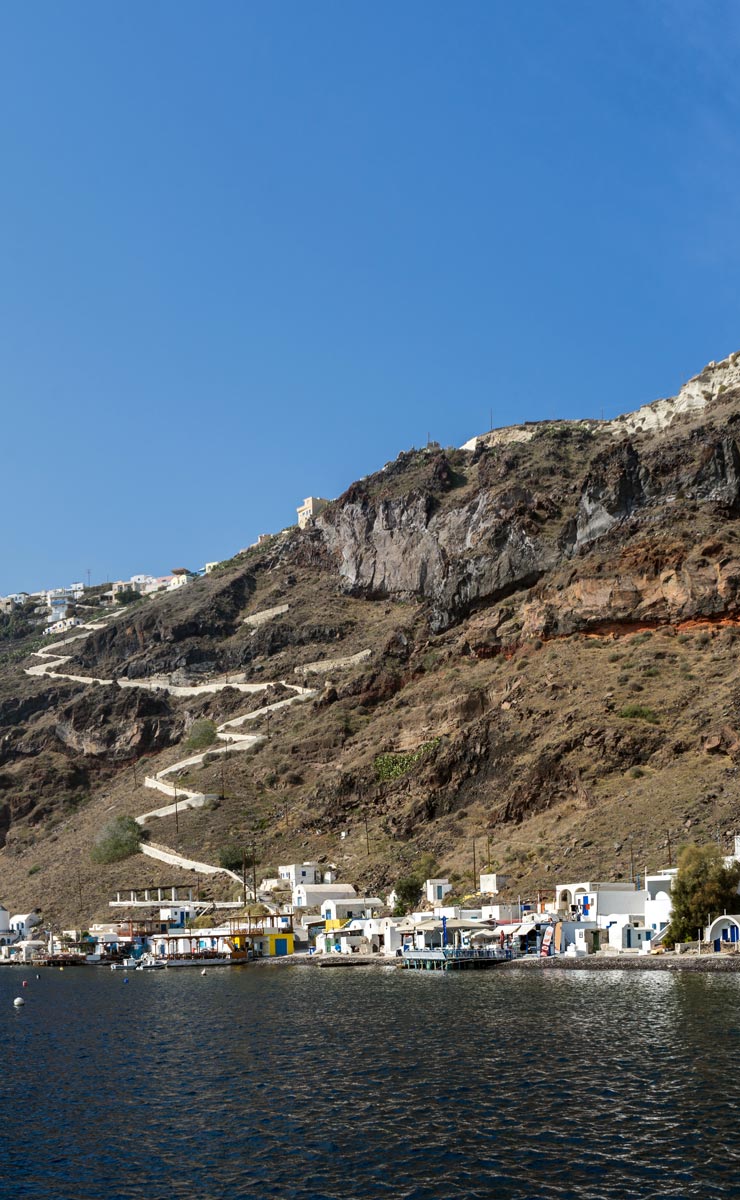Thirasia (pronounced Thirah-SEE-ah) is in some ways the invisible Cycladic island. That's because it is just across the caldera from superstar tourist destination Santorini (Or Thira, which is its older, Greek name). It's essentially western lip of the exploded volcano of which Santorini is by far the biggest surviving piece. Another reason why for its near invisibility is that it's only about one-tenth the size of Santorini. Sometimes Thirasia, Santorini and the other 3 small islands within the circle of the ancient volcano they used to be part of before they separated into islands of their own when the volcano blew 3,600 years ago are known as the Santorini Island Complex.
One obvious thing that Thirasia offers which you cannot find on otherwise very scenic Santorini is...a great view of Santorini, its chocolate-colored cliffs, and the snowy white topping of its buildings on the calders's summit. Thirasia is home to about 300 year-round residents, divided into 5 small villages, one of which (Agrilla) is now unpopulated, and another (Ormos Korfou) with a population of 2. The boats to Thirasia docks at Agia Irini (pop. 90) on the island's north end, and at 2.5km the closest point to Santorini. The two islands had been connected by a land bridge until 236 BC, when a volcanic upheaval created the gap between the two.
Thirasia not only does not have the crowds of Santorini, it doesn't have much in the way of accommodation, although it is still worth a visit. It's chief problem is the lack of decent beaches, and as beaches are 90% of the reason people vacation on the Greek islands, its raison d'etre as a tourist destination almost completely evaporates.
Having said that, however, Thirasia has some really interesting aspects. Its largest village Manolas (or Thirasia- pop. 147), is sort of a mini version of Santorini's cliff top capital, Oia (or Fira). Going there, you get an idea what Oia was like before all those tourists came.
It has windmills, and some cave houses, and the whitewashed cubic-shaped dwellings you find on the Cycladic Islands. It some really interesting color schemes on some of the houses- burnt orange with blue doors, or cherry red with blue-shuttered, white bordered windows. From Manolas you can walk along the caldera about 3km to the Kimisis Monastery at the island's southern tip, which clings to the caldera lip like a bird's nest.
About halfway to the monastery you pass the abandoned village of Kera (another place with 0 population), and the pretty little St. Irene chapel. (St. Irene is where the Italian-originated name "Santorini" comes from.) A highlight of this little island are the many scenic chapels. They are all cute, compact, and display interesting color schemes, blue on white of course being the predominant one.
Here's a story that says it all about Thirasia being a bit of old Greece. A visitor to the island a few years ago had a nice meal at the Panorama restaurant in Manolas. She walked off after her meal, leaving her iphone and purse (including credit cards, ID, and a fair amount of cash), on her table. When she came back a half hour later the owner, whose daughter had found the things when she came to clear the table, handed everything back to the woman. Needless to say, she posted a glowing online review of the island. Thirasia is worth at least a day trip for anyone visiting Santorini and wanting to dodge the crowds for awhile.












